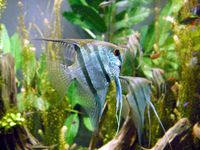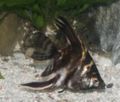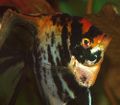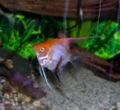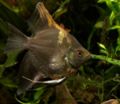Angelfish (Pterophyllum scalare)
Pterophyllum scalare
114 Litres (30 US G.)
12.7-15.2cm (5-6 ")
Freshwater
6.5 - 7.2
23.9-25.6°C (75 -78 °F)
6-9 °d
1:2 M:F
5-9 years
Family
Cichlidae
This animal is available captive bred
Contents
Additional names
Additional scientific names
- Platax scalaris, Plataxoides dumerilii, Pterophillum eimekei, Pterophyllum dumerilii, Pterophyllum eimekei, Zeus scalaris
Origin[edit]
- Found throughout the Amazon River Basin, in Peru, Colombia, and Brazil, along the Ucayali, Solimões and Amazon rivers; rivers of Amapá (Brazil), Rio Oyapock in French Guiana; Essequibo River in Guyana.
Sexing[edit]
- Extremely difficult. Look for a slight nuchal hump on mature males, although it's not always accurate. The best way to sex is to look at the breeding tubes on a pair when they are spawning. The male's breeding tube will be much smaller than the female's.
Tank compatibility[edit]
- Compatible with some South American Cichlids such as the German Blue Ram or any of the Apistogramma species. Do not keep with small tetras or other small fish 3.8cm (1.5") and under, they may well become lunch, or with overly aggressive fish. Avoid known fin nippers such as Tiger Barbs or Serpae Tetras. Other territorial mid-top dwellers such as Betta splendens and Gouramis are not advisable either as they may become too curious towards the Angels.
Diet[edit]
- Angels will accept most foods include live/frozen such as brine shrimp and good quality cichlid pellets. Keep the diet varied for optimum health.
Feeding regime[edit]
- Feed once or twice a day.
Environment specifics[edit]
- This fish requires a water column at least 38cm (15") in depth as these fish grow tall rather than long.
- This fish likes an area of substrate to sift through while looking for food. Care should be taken however, if the substrate consists of small pea gravel that it should not accidentally choke on a piece. They also appreciate live plants, good filtration, and plenty of swimming room.
Behaviour[edit]
- Angelfish are Cichlids that are good tank mates to other quiet fish. Energetic fish such as Tiger Barbs and Black Skirt Tetras are not good tank mates. Sometimes large Angelfish will become aggressive towards others, this can be genetic aggression or a result of establishing territory to breed. Using a divider is a great way to separate an aggressive Angel or breeding pair.
- While Angelfish have been known to eat small fish, this can be largely prevented by adding small fish when the Angelfish is very young. It then doesn't regard these fish as food. It also appears to lessen the bullying of other Angels.
- Each Angelfish needs 38 Litres (10 US G.) of the tank dedicated to it but if more than one Angelfish is kept in a 132-151 Litres (35-40 US G.) tank, even if they are a breeding pair, it is very likely that one will begin to attack the other and it will eventually sicken and die. This behaviour usually manifests after they have bred or attempted to breed one or more times.
- When Angelfish reach breeding age, no matter what size the tank is, a pair will set up housekeeping and be very aggressive when protecting their eggs. They will be unlikely to successfully breed in a community tank, however.
Identification[edit]
- A high-bodied laterally-depressed triangular-shaped fish. Long dorsal and anal fins, not a long fish but very tall. A very distinctive looking and popular fish. "Veil tail" varieties are becoming more common, where the dorsal, anal and caudal fins are all dramatically elongated.
Pictures[edit]
Colour variations of Angelfish[edit]
Wild-Type[edit]
This is how wild Angelfish would appear. Silver in base colour with several vertical dark bands.
Marble Angelfish[edit]
Has a mottled colouration of black, and white. Those with yellow or orange can be classed as Gold Marble or Koi Marble.
Gold Angelfish[edit]
Also referred to as Koi if black markings are evident. Usually devoid of stripes which can vary in colour from light silver yellow, to dark yellow, even showing some orange especially when mature. Some show slight marbling or dark markings when young.
Ghost Angelfish[edit]
These Angels have a gene that eliminates their natural stripes on all but their fins. The body is generally pale with no markings, occasionally there will be black spots however.
Blushing Angelfish[edit]
Similar to ghost angelfish, blushing angelfish are stripeless. The "blushing" term refers to the red color around their gills, caused by oxygenated blood showing through the translucent gill plates. They are often somewhat colorless, though some take on a silvery, gold, or bluish sheen.
Smokey Angelfish[edit]
This Angel has a silver base colour with lightly mottled dark patches and dark fins.
Black Angelfish[edit]
The Black Angel does exactly what it says on the tin, the body and fins are black in colour.
Half-Black Angelfish[edit]
Resembles a regular silver Angel but the back half of the fish is solid black. Other black markings may be visible on the rest of the body.
Chocolate Angelfish[edit]
Chocolate Angelfish are an uncommon colour, they are a deep mottled rich brown and will occasionally have the wild-type vertical bars.
Pearlscale Angelfish[edit]
This can occur on any colour base, it is a recessive gene that produces a crinkled tinfoil appearance to the scales of the fish as they get older.
Platinum Angelfish[edit]
Platinums are solid white in colour with no black or orange markings.
Albino Angelfish[edit]
Not often seen. Albinos do not produce any dark pigments and therefore show a white to yellow body. Normally dark markings are replaced by markings that are lighter than the baseline body colour. As in most albinos, the eyes are red and in colour varieties that would normally have a red iris, the iris of the albino is intensely red.
Videos[edit]
| Angelfish spawning: |
Species Note[edit]
- An Angelfish hybrid of P. scalare and Pterophyllum altum has been bred in captivity and seen on show in 2010, although not yet seen in the trade. They have the tall dorsal fin and vertical banding of the Altum and get to around 25.4cm (10") tall.
Commercial Breeders[edit]
External links[edit]
- Fishbase (Mirrors:
 )
)
